Abstract
In vitro pure culture studies were conducted on three different strains of Escherichia coli (K-12, EPA 00244, and SWEI) to determine the effect of chlorination on catalase activity. In each case, stationary-phase cells exhibited significant (P less than 0.001) reductions in enzyme activity following exposure to chlorine. Mean differences in activity between control and chlorine-stressed cells ranged from 8.8 to 20.3 U/mg of protein for E. coli SWEI and EPA 00244, respectively. Following initial enzyme studies, resuscitation experiments utilizing the membrane filtration technique were conducted on chlorinated sewage effluent. Five different amendments, including catalase (1,000 U per plate), heat-inactivated catalase (1,000-U per plate), sodium pyruvate (0.05%), a catalase-sodium pyruvate combination (1,500 U/0.01%), and acetic acid (0.05%), were tested for the ability to enhance detection of chlorine-stressed cells on M-fecal coliform (M-FC), mT7, M-Endo, and tryptone-glucose-yeast extract (TGY) media. Significant (P less than 0.001) increases in recovery of fecal coliforms on M-FC, total coliforms on mT7 and M-Endo, and total heterotrophs on TGY were obtained on plates containing catalase, pyruvate, or the combination of these compounds. Supplementation with heat-inactivated catalase and acetic acid did not improve recovery of chlorine-stressed cells compared with recovery on nonamended media. Subsequent analysis of colonies from plates containing compounds which enhanced recovery indicated coliform verification percentages of greater than 80% on M-FC, greater than 90% on mT7, and greater than 94% on M-Endo media. These data suggest that the addition of peroxide-degrading compounds to various standard recovery media may improve detection of both coliform and heterotrophic bacteria in chlorinated waters.
Full text
PDF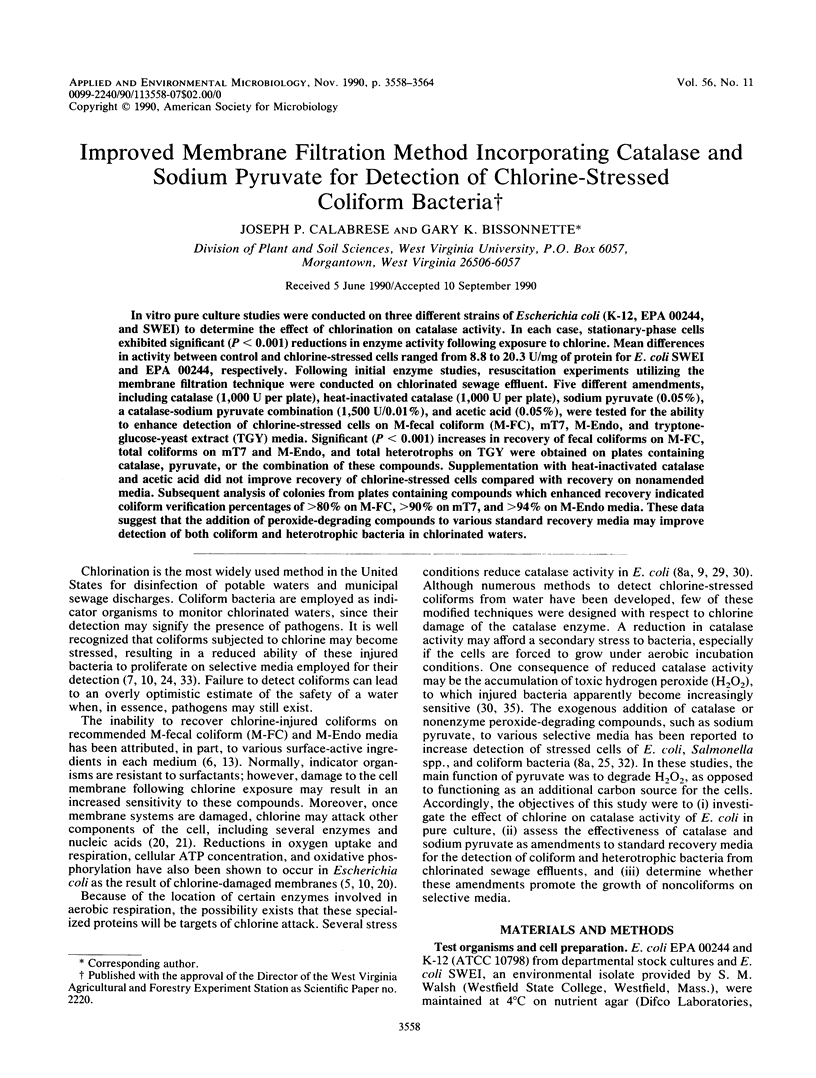
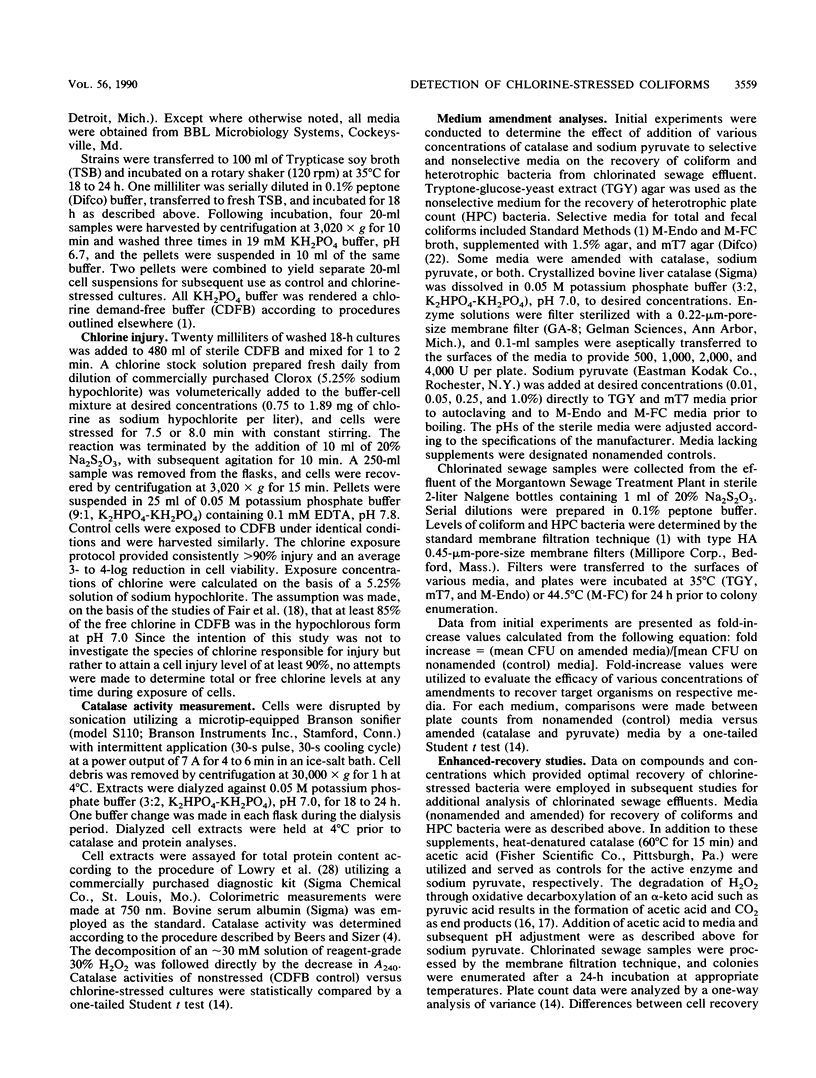
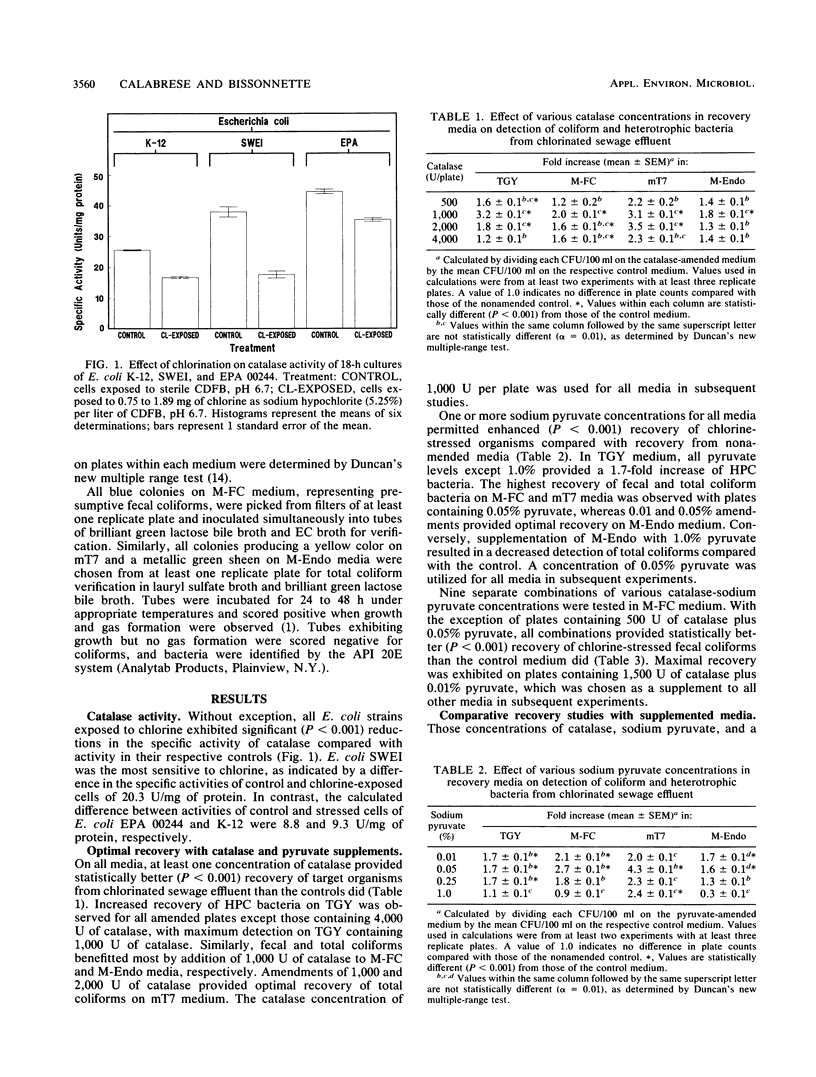
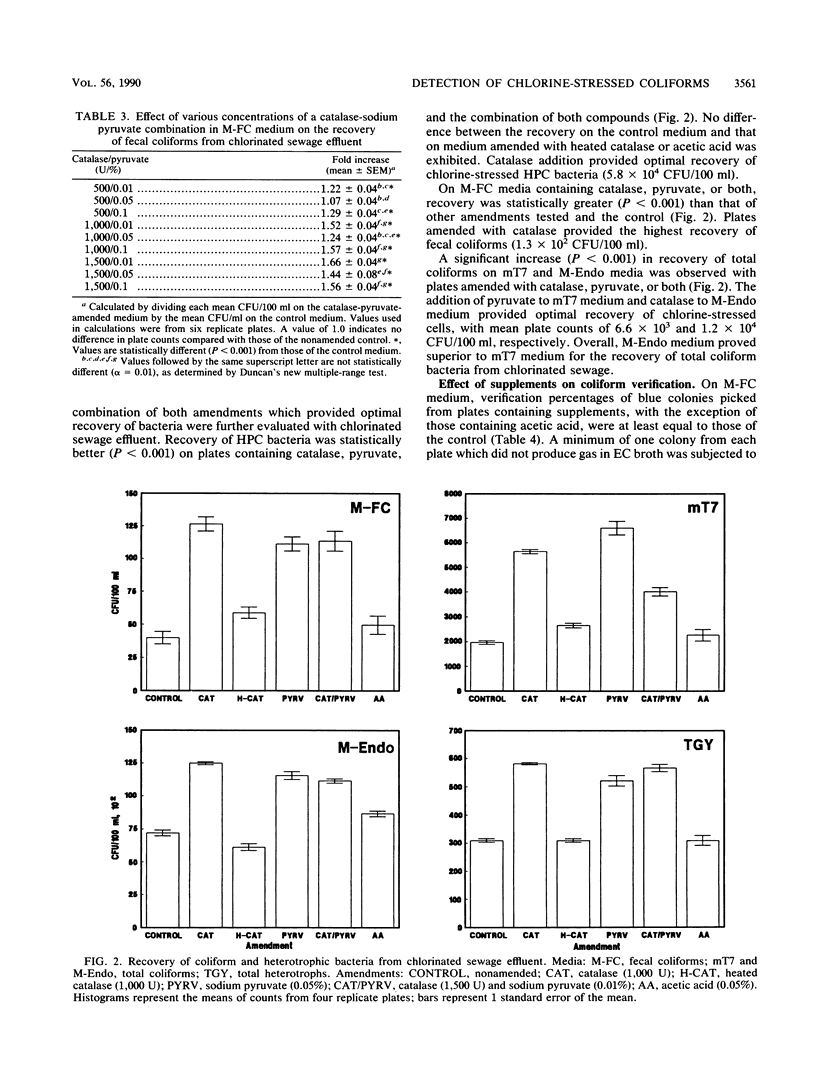
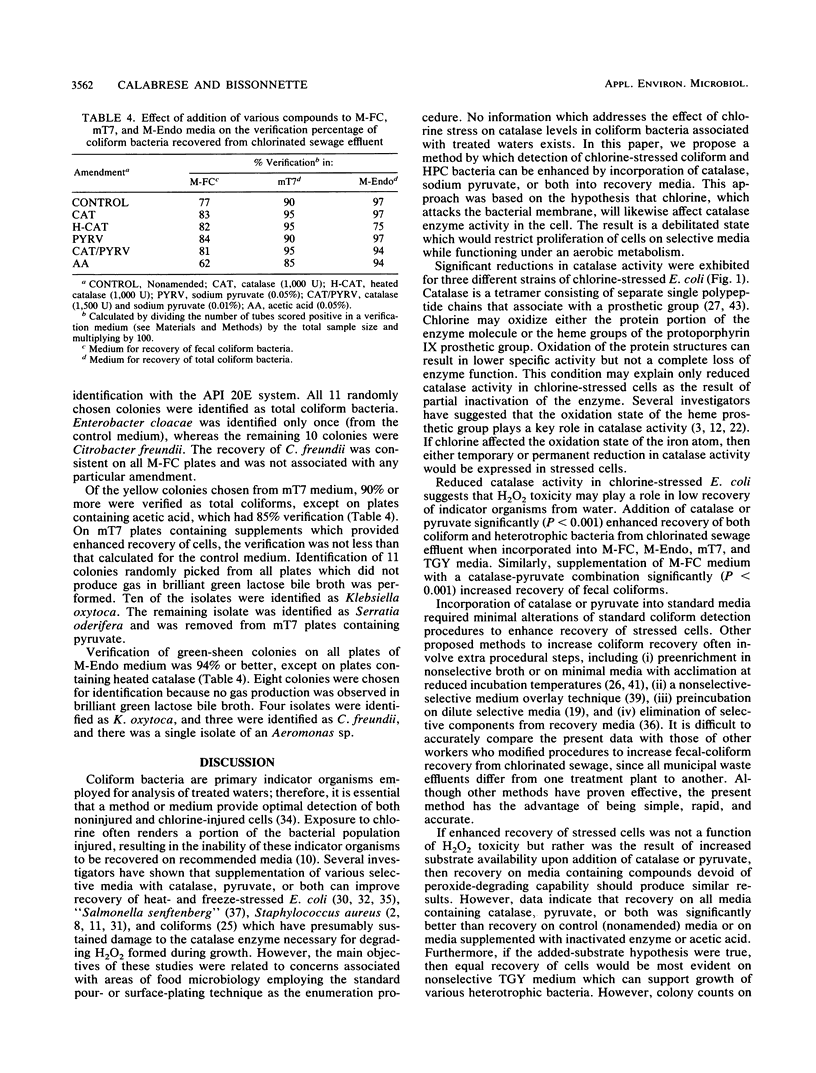
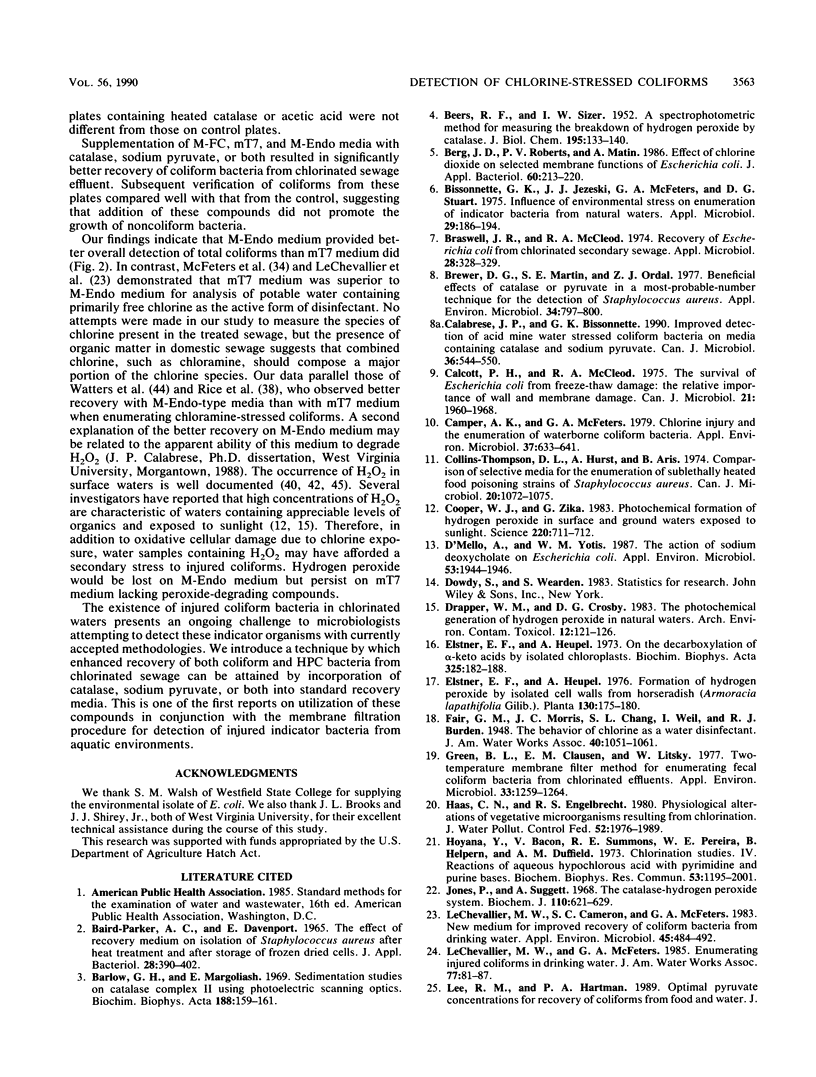
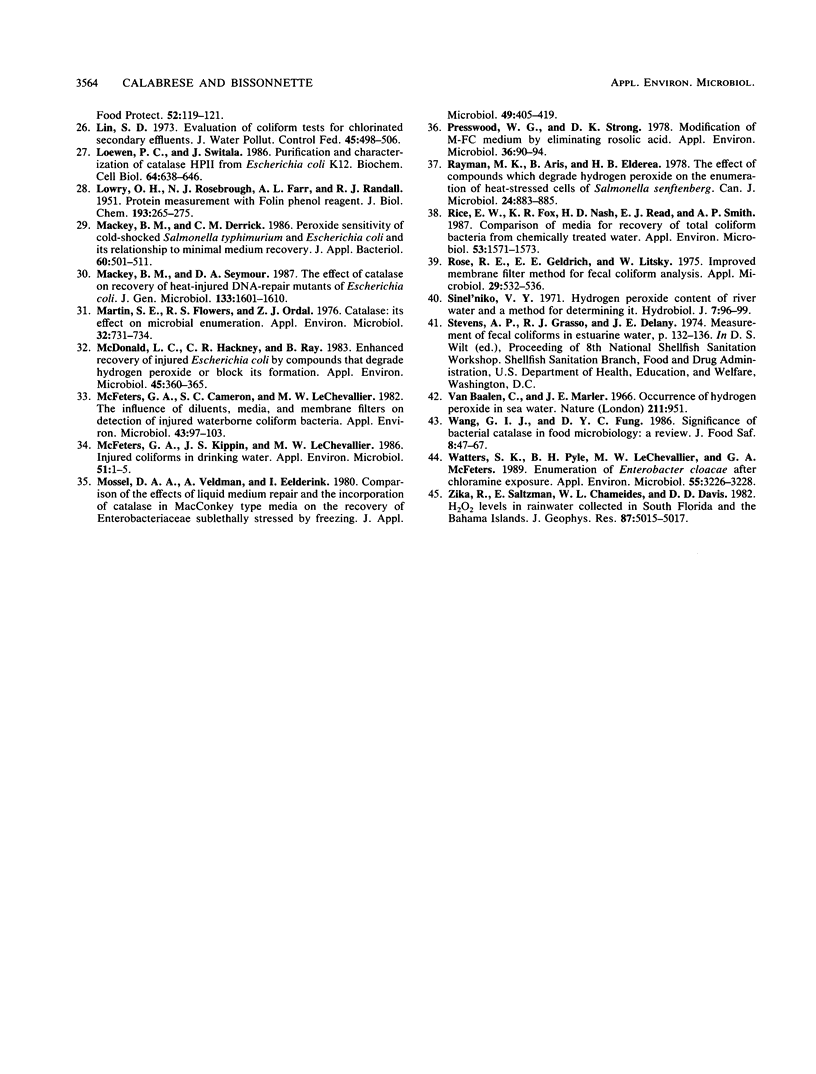
Selected References
These references are in PubMed. This may not be the complete list of references from this article.
- BEERS R. F., Jr, SIZER I. W. A spectrophotometric method for measuring the breakdown of hydrogen peroxide by catalase. J Biol Chem. 1952 Mar;195(1):133–140. [PubMed] [Google Scholar]
- Bairdparker A. C., Davenport E. The effect of recovery medium on the isolation of Staphylococcus aureus after heat treatment and after the storage of frozen or dried cells. J Appl Bacteriol. 1965 Dec;28(3):390–402. doi: 10.1111/j.1365-2672.1965.tb02169.x. [DOI] [PubMed] [Google Scholar]
- Barlow G. H., Margoliash E. Sedimentation studies on catalase Complex II using photoelectric scanning optics. Biochim Biophys Acta. 1969 Aug 12;188(1):159–161. doi: 10.1016/0005-2795(69)90057-9. [DOI] [PubMed] [Google Scholar]
- Berg J. D., Roberts P. V., Matin A. Effect of chlorine dioxide on selected membrane functions of Escherichia coli. J Appl Bacteriol. 1986 Mar;60(3):213–220. doi: 10.1111/j.1365-2672.1986.tb01075.x. [DOI] [PubMed] [Google Scholar]
- Bissonnette G. K., Jezeski J. J., McFeters G. A., Stuart D. G. Influence of environmental stress on enumeration of indicator bacteria from natural waters. Appl Microbiol. 1975 Feb;29(2):186–194. doi: 10.1128/am.29.2.186-194.1975. [DOI] [PMC free article] [PubMed] [Google Scholar]
- Braswell J. R., Hoadley A. W. Recovery of Escherichia coli from chlorinated secondary sewage. Appl Microbiol. 1974 Aug;28(2):328–329. doi: 10.1128/am.28.2.328-329.1974. [DOI] [PMC free article] [PubMed] [Google Scholar]
- Brewer D. G., Martin S. E., Ordal Z. J. Beneficial effects of catalase or pyruvate in a most-probable-number technique for the detection of Staphylococcus aureus. Appl Environ Microbiol. 1977 Dec;34(6):797–800. doi: 10.1128/aem.34.6.797-800.1977. [DOI] [PMC free article] [PubMed] [Google Scholar]
- Calabrese J. P., Bissonnette G. K. Improved detection of acid mine water stressed coliform bacteria on media containing catalase and sodium pyruvate. Can J Microbiol. 1990 Aug;36(8):544–550. doi: 10.1139/m90-095. [DOI] [PubMed] [Google Scholar]
- Calcott P. H., MacLeod R. A. The survival of Escherichia coli from freeze-thaw damage: the relative importance of wall and membrane damage. Can J Microbiol. 1975 Dec;21(12):1960–1968. doi: 10.1139/m75-284. [DOI] [PubMed] [Google Scholar]
- Camper A. K., McFeters G. A. Chlorine injury and the enumeration of waterborne coliform bacteria. Appl Environ Microbiol. 1979 Mar;37(3):633–641. doi: 10.1128/aem.37.3.633-641.1979. [DOI] [PMC free article] [PubMed] [Google Scholar]
- Collins-Thompson D. L., Hurst A., Aris B. Comparison of selective media for the enumeration of sublethally heated food-poisoning strains of Staphylococcus aureus. Can J Microbiol. 1974 Jul;20(7):1072–1075. doi: 10.1139/m74-168. [DOI] [PubMed] [Google Scholar]
- Cooper W. J., Zika R. G. Photochemical formation of hydrogen peroxide in surface and ground waters exposed to sunlight. Science. 1983 May 13;220(4598):711–712. doi: 10.1126/science.220.4598.711. [DOI] [PubMed] [Google Scholar]
- D'Mello A., Yotis W. W. The action of sodium deoxycholate on Escherichia coli. Appl Environ Microbiol. 1987 Aug;53(8):1944–1946. doi: 10.1128/aem.53.8.1944-1946.1987. [DOI] [PMC free article] [PubMed] [Google Scholar]
- Elstner E. F., Heupel A. On the decarboxylation of alpha-keto acids by isolated chloroplasts. Biochim Biophys Acta. 1973 Oct 19;325(1):182–188. doi: 10.1016/0005-2728(73)90164-3. [DOI] [PubMed] [Google Scholar]
- Green B. L., Clausen E. M., Litsky W. Two-temperature membrane filter method for enumerating fecal coliform bacteria from chlorinated effluents. Appl Environ Microbiol. 1977 Jun;33(6):1259–1264. doi: 10.1128/aem.33.6.1259-1264.1977. [DOI] [PMC free article] [PubMed] [Google Scholar]
- Haas C. N., Engelbrecht R. S. Physiological alterations of vegetative microorganisms resulting form chlorination. J Water Pollut Control Fed. 1980 Jul;52(7):1976–1989. [PubMed] [Google Scholar]
- Hoyano Y., Bacon V., Summons R. E., Pereira W. E., Halpern B., Duffield A. M. Chlorination studies. IV. The reaction of aqueous hypochlorous acid with pyrimidine and purine bases. Biochem Biophys Res Commun. 1973 Aug 21;53(4):1195–1199. doi: 10.1016/0006-291x(73)90591-3. [DOI] [PubMed] [Google Scholar]
- Jones P., Suggett A. The catalase-hydrogen peroxide system. A theoretical appraisal of the mechanism of catalase action. Biochem J. 1968 Dec;110(4):621–629. doi: 10.1042/bj1100621. [DOI] [PMC free article] [PubMed] [Google Scholar]
- LOWRY O. H., ROSEBROUGH N. J., FARR A. L., RANDALL R. J. Protein measurement with the Folin phenol reagent. J Biol Chem. 1951 Nov;193(1):265–275. [PubMed] [Google Scholar]
- LeChevallier M. W., Cameron S. C., McFeters G. A. New medium for improved recovery of coliform bacteria from drinking water. Appl Environ Microbiol. 1983 Feb;45(2):484–492. doi: 10.1128/aem.45.2.484-492.1983. [DOI] [PMC free article] [PubMed] [Google Scholar]
- Lin S. Evaluation of coliform tests for chlorinated secondary effluents. J Water Pollut Control Fed. 1973 Mar;45(1):498–506. [PubMed] [Google Scholar]
- Loewen P. C., Switala J. Purification and characterization of catalase HPII from Escherichia coli K12. Biochem Cell Biol. 1986 Jul;64(7):638–646. doi: 10.1139/o86-088. [DOI] [PubMed] [Google Scholar]
- Mackey B. M., Derrick C. M. Peroxide sensitivity of cold-shocked Salmonella typhimurium and Escherichia coli and its relationship to minimal medium recovery. J Appl Bacteriol. 1986 Jun;60(6):501–511. doi: 10.1111/j.1365-2672.1986.tb01089.x. [DOI] [PubMed] [Google Scholar]
- Mackey B. M., Seymour D. A. The effect of catalase on recovery of heat-injured DNA-repair mutants of Escherichia coli. J Gen Microbiol. 1987 Jun;133(6):1601–1610. doi: 10.1099/00221287-133-6-1601. [DOI] [PubMed] [Google Scholar]
- Martin S. E., Flowers R. S., Ordal Z. J. Catalase: its effect on microbial enumeration. Appl Environ Microbiol. 1976 Nov;32(5):731–734. doi: 10.1128/aem.32.5.731-734.1976. [DOI] [PMC free article] [PubMed] [Google Scholar]
- McDonald L. C., Hackney C. R., Ray B. Enhanced recovery of injured Escherichia coli by compounds that degrade hydrogen peroxide or block its formation. Appl Environ Microbiol. 1983 Feb;45(2):360–365. doi: 10.1128/aem.45.2.360-365.1983. [DOI] [PMC free article] [PubMed] [Google Scholar]
- McFeters G. A., Cameron S. C., LeChevallier M. W. Influence of diluents, media, and membrane filters on detection fo injured waterborne coliform bacteria. Appl Environ Microbiol. 1982 Jan;43(1):97–103. doi: 10.1128/aem.43.1.97-103.1982. [DOI] [PMC free article] [PubMed] [Google Scholar]
- McFeters G. A., Kippin J. S., LeChevallier M. W. Injured coliforms in drinking water. Appl Environ Microbiol. 1986 Jan;51(1):1–5. doi: 10.1128/aem.51.1.1-5.1986. [DOI] [PMC free article] [PubMed] [Google Scholar]
- Mossel D. A., Veldman A., Eelderink I. Comparison of the effects of liquid medium repair and the incorporation of catalase in MacConkey type media on the recovery of Enterobacteriaceae sublethally stressed by freezing. J Appl Bacteriol. 1980 Dec;49(3):405–419. doi: 10.1111/j.1365-2672.1980.tb04716.x. [DOI] [PubMed] [Google Scholar]
- Presswood W. G., Strong D. K. Modification of M-FC medium by eliminating rosolic acid. Appl Environ Microbiol. 1978 Jul;36(1):90–94. doi: 10.1128/aem.36.1.90-94.1978. [DOI] [PMC free article] [PubMed] [Google Scholar]
- Rayman M. K., Aris B., El Derea H. B. The effect of compounds which degrade hydrogen peroxide on the enumeration of heat-stressed cells of Salmonella senftenberg. Can J Microbiol. 1978 Jul;24(7):883–885. doi: 10.1139/m78-146. [DOI] [PubMed] [Google Scholar]
- Rice E. W., Fox K. R., Nash H. D., Read E. J., Smith A. P. Comparison of media for recovery of total coliform bacteria from chemically treated water. Appl Environ Microbiol. 1987 Jul;53(7):1571–1573. doi: 10.1128/aem.53.7.1571-1573.1987. [DOI] [PMC free article] [PubMed] [Google Scholar]
- Rose R. E., Geldreich E. E., Litsky W. Improved membrane filter method for fecal coliform analysis. Appl Microbiol. 1975 Apr;29(4):532–536. doi: 10.1128/am.29.4.532-536.1975. [DOI] [PMC free article] [PubMed] [Google Scholar]
- Watters S. K., Pyle B. H., LeChevallier M. W., McFeters G. A. Enumeration of Enterobacter cloacae after chloramine exposure. Appl Environ Microbiol. 1989 Dec;55(12):3226–3228. doi: 10.1128/aem.55.12.3226-3228.1989. [DOI] [PMC free article] [PubMed] [Google Scholar]


